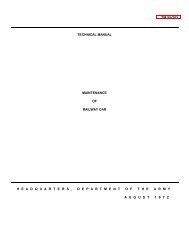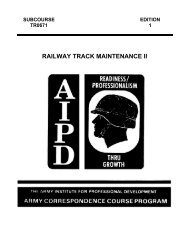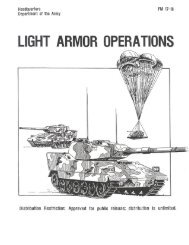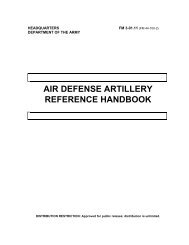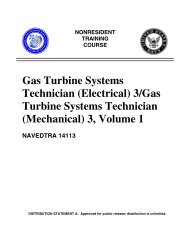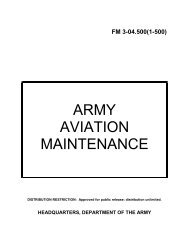fm 44-100 us army air and missile defense operations
fm 44-100 us army air and missile defense operations
fm 44-100 us army air and missile defense operations
You also want an ePaper? Increase the reach of your titles
YUMPU automatically turns print PDFs into web optimized ePapers that Google loves.
FM<strong>44</strong>-<strong>100</strong><br />
identification authority to lower echelons is normal for ADA <strong>and</strong> non-ADA<br />
units that do not have near-real-time transmission capability for<br />
identification data. Such units have both identification <strong>and</strong> engagement<br />
authority. Capabilities dictate that ADA units engage threatening ballistic<br />
<strong>missile</strong>s <strong>and</strong> ASMs based on classification, not identification.<br />
Weapon Control Stat<strong>us</strong><br />
5-106. Weapon control stat<strong>us</strong>es (weapons free, weapons tight, weapons hold)<br />
describe the relative degree of control of <strong>air</strong> <strong>defense</strong> fires. Weapon control<br />
stat<strong>us</strong>es apply to weapon systems, volumes of <strong>air</strong>space, or types of <strong>air</strong><br />
platforms. The degree or extent of control varies depending on the tactical<br />
situation. Establishment of separate weapon control stat<strong>us</strong>es for fixed <strong>and</strong><br />
rotary wing <strong>air</strong>craft, UAV <strong>and</strong> for <strong>missile</strong>s is normal. Air <strong>and</strong> <strong>missile</strong> <strong>defense</strong><br />
forces m<strong>us</strong>t have the ability to receive <strong>and</strong> disseminate weapon control<br />
stat<strong>us</strong>es for all classes of <strong>air</strong> platforms.<br />
5-107. Weapons Free. Weapons can fire at any <strong>air</strong> target not positively<br />
identified as friendly. This is the least restrictive weapon control stat<strong>us</strong>.<br />
5-108. Weapons Tight. Fire only at <strong>air</strong> targets that are identified as hostile<br />
according to the prevailing hostile criteria. Identification can be effected by a<br />
number of means to include visual identification (aided or unaided),<br />
electronic, or procedural means. Capabilities dictate that ADA units engage<br />
threatening ballistic <strong>missile</strong>s <strong>and</strong> ASMs based on classification, not<br />
identification.<br />
5-109. Weapons Hold. Do not fire except in self-<strong>defense</strong> or in response to a<br />
formal order. This is the most restrictive weapon control stat<strong>us</strong>.<br />
5-110. There is no difference between weapons free <strong>and</strong> weapons tight for<br />
theater <strong>missile</strong> targets. Normally, ADA units will <strong>us</strong>e weapons tight to allow<br />
theater <strong>missile</strong> engagements <strong>and</strong> do not <strong>us</strong>e weapons free with respect to<br />
theater <strong>missile</strong> targets.<br />
Level of Control<br />
5-111. Level of control describes the AD echelon at which positive<br />
management of the <strong>air</strong> battle is being conducted. This can be an AADC,<br />
RADC, SADC, ADA brigade FDC, battalion FDC, or the individual fire unit.<br />
This is the level that has engagement authority. This may be a different level<br />
for fixed-wing <strong>air</strong>craft, rotary-wing <strong>air</strong>craft, UAVs, <strong>and</strong> theater <strong>missile</strong>s. The<br />
AADC will specify the level of control in the <strong>air</strong> <strong>defense</strong> plan <strong>and</strong> this may<br />
change over the course of an operation.<br />
5-112. Engagement authority is delegated to the lowest level in SHORAD fire<br />
units. HIMAD fire units normally have engagement authority for theater<br />
<strong>missile</strong> engagements; however, the engagement authority for <strong>air</strong>craft is<br />
normally at SADC or higher.<br />
Modes of Control<br />
5-113. Two modes of control are centralized <strong>and</strong> decentralized. The mode of<br />
control selected will depend upon the capabilities of the C4I system, the<br />
5-25




